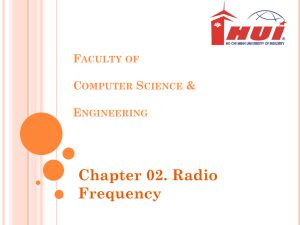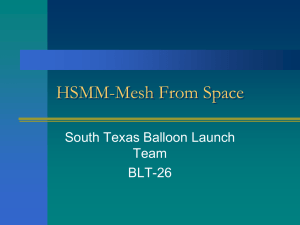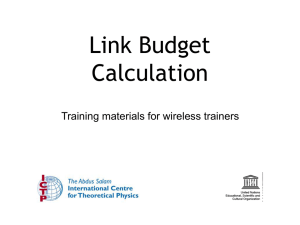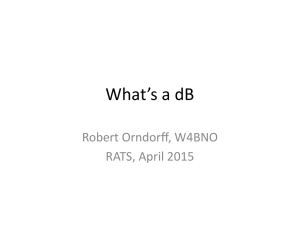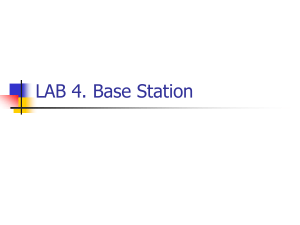Units, dB & stuff: understanding each others` lingo - Clegg
advertisement
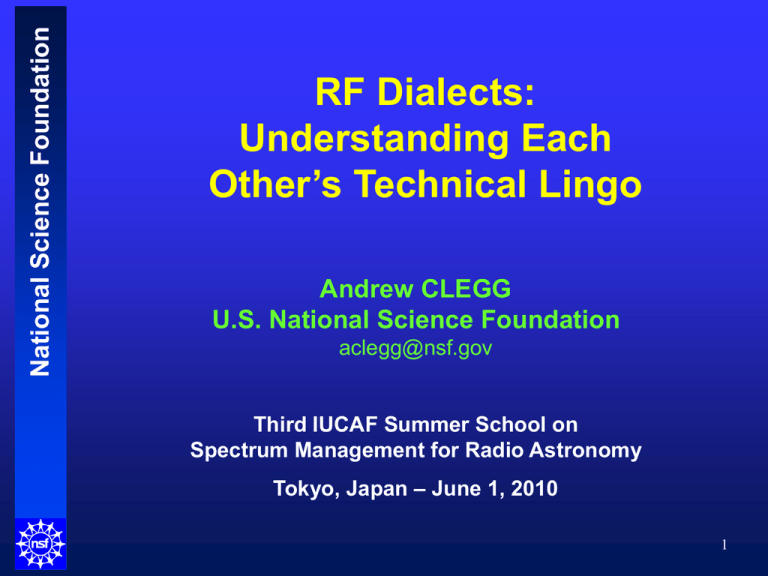
National Science Foundation RF Dialects: Understanding Each Other’s Technical Lingo Andrew CLEGG U.S. National Science Foundation aclegg@nsf.gov Third IUCAF Summer School on Spectrum Management for Radio Astronomy Tokyo, Japan – June 1, 2010 1 National Science Foundation Radio Astronomers Speak a Unique Vernacular “We are receiving interference from your transmitter at a level of 10 janskys” “What the ^#$& is a ‘jansky’?” 2 National Science Foundation Spectrum Managers Need to Understand a Unique Vernacular “Huh?” “We are using +43 dBm into a 15 dBd slant-pol panel with 2 degree electrical downtilt” 3 National Science Foundation Why Bother Learning other RF Languages? • • • Radio Astronomy is the “Leco” of RF languages, spoken by comparatively very few people Successful coordination is much more likely to occur and much more easily accommodated when the parties involved understand each other’s lingo It’s less likely that our spectrum management brethren will bother learning radio astronomy lingo—we need to learn theirs 4 National Science Foundation Terminology… • • • • • • • • • dBm dBW V/m dBV/m ERP EIRP dBi dBd C/I • • • • • • • • • C/(I+N) Noise Figure Noise Factor Cascaded Noise Factor Line Loss Insertion Loss Ideal Isotropic Antenna Reference Dipole Others… 5 National Science Foundation Received Signal Strength 6 National Science Foundation • • Received Signal Strength: Radio Astronomy The jansky (Jy): > 1 Jy 10-26 W/m2/Hz > The jansky is a measure of spectral power flux density—the amount of RF energy per unit time per unit area per unit bandwidth The jansky is not used outside of radio astronomy > It is not a practical unit for measuring communications signals The magnitude is much too small The jansky is a linear unit > Very few RF engineers outside of radio astronomy will know what a Jy is 7 National Science Foundation Received Signal Strength: Communications • • The received signal strength of most communications signals is measured in power > The relevant bandwidth is fixed by the bandwidth of the desired signal > The relevant collecting area is fixed by the frequency of the desired signal and the gain of the receiving antenna Because of the wide dynamic range encountered by most radio systems, the power is usually expressed in logarithmic units of watts (dBW) or milliwatts (dBm): > dBW 10log10(Power in watts) > dBm 10log10(Power in milliwatts) 8 National Science Foundation Translating Jy into dBm • While not comprised of the same units, we can make some reasonable assumptions to compare a Jy to dBm. 9 National Science Foundation Jy into dBm • • • Assumptions > GSM bandwidth (~200 kHz) > 1.8 GHz frequency ( = 0.17 m) > Isotropic receive antenna Antenna collecting area = 2/4 = 0.0022 m2 How much is a Jy worth in dBm? > PmW = 10-26 W/m2/Hz 200,000 Hz 0.0022 m2 1000 mW/W = 4.410-21 mW > PdBm = 10 log (4.410-21 mW) = –204 dBm Radio astronomy observations can achieve microjansky sensitivity, corresponding to signal levels (under the same assumptions) of –264 dBm 10 National Science Foundation Jy into dBm: Putting it into Context • • • The reference GSM handset receiver sensitivity is –111 dBm (minimum reported signal strength; service is not available at this power level) A 1 Jy signal strength (~-204 dBm) is therefore some 93 dB below the GSM reference receiver sensitivity A Jy is a whopping 153 dB below the GSM handset reference sensitivity A radio telescope can be more than 15 orders of magnitude more sensitive than a GSM receiver 11 National Science Foundation • • • Other Units of Received Signal Strength: V/m Received signal strengths for communications signals are sometimes specified in units of V/m or dB(V/m) > You will see V/m used often in specifying limits on unlicensed emissions [for example in the U.S. FCC’s Unlicensed Devices (Part 15) rules] and in service area boundary emission limits (multiple FCC rule parts) This is simply a measure of the electric field amplitude (E) Ohm’s Law can be used to convert the electric field amplitude into a power flux density (power per unit area): > P(W/m2) = E2/Z0 > Z0 (0/0)1/2 = 377 = the impedance of free space 12 National Science Foundation dBV/m to dBm Conversion • Under the assumption of an isotropic receiving antenna, conversion is just a matter of algebra: 2 EV/m PW / m Z0 () 2 (Ohm’s law) 2 2 2 106 EμV / m 1021 EμV c2 / m cm /s 2 P(mW) 1000P(W/m ) 1000 6 2 2 4 Z0 () 4 (10 f MHz) 4Z0 () f MHz 2 • Which results in the following conversions: -2 P(mW ) 1.9 108 E μV2 / m f MHz P(dBm) 77.2 E dBV/m 20 log10 f MHz , where E dBV/m 20 log10 E μV / m 13 National Science Foundation Conversion Example • In Japan, the minimum required field strength for a digital TV protected service area is 60 dB(V/m). At a frequency of 600 MHz, this corresponds to a received power of: P(dBm) = -77.2 + 60 – 20log10(600 MHz) = -73 dBm 14 National Science Foundation Antenna Performance 15 National Science Foundation Antenna Performance: Radio Astronomy • • Radio astronomers are typically converting power flux density or spectral power flux density (both measures of power or spectral power density per unit area) into a noise-equivalent temperature A common expression of radio astronomy antenna performance is the rise in system temperature attributable to the collection of power in a single polarization from a source of total flux density of 1 Jy: 1 F Ae kBTK 2k T Ae (m2 ) B26 K 2760GK/Jy 10 FJy 2 • The effective antenna collecting area Ae is a combination of the geometrical collecting area Ag (if defined) and the aperture efficiency a > Ae = a Ag 16 National Science Foundation Antenna Performance Example: Nobeyama 45-m Telescope @ 24 GHz • • • • Measured gain is ~0.36 K/Jy Effective collecting area: > Ae(m2) = 2760 * 0.3 K/Jy = 994 m2 Geometrical collecting area: > Ag = π(45m/2)2 = 1590 m2 Aperture efficiency = 994/1590 = 63% 17 National Science Foundation Antenna Performance: Communications • • Typical communications applications specify basic antenna performance by a different expression of antenna gain: > Antenna Gain: The amount by which the signal strength at the output of an antenna is increased (or decreased) relative to the signal strength that would be obtained at the output of a standard reference antenna, assuming maximum gain of the reference antenna Antenna gain is normally direction-dependent 18 National Science Foundation Common Standard Reference Antennas • 1 0.5 Isotropic > > > > 0 -0.5 -1 1 0.5 1 0.5 0 0 -0.5 “Point source” antenna Uniform gain in all directions Effective collecting area 2/4 Theoretical only; not achievable in the real world -0.5 -1 -1 • Half-wave Dipole > Two thin conductors, each /4 in length, laid end-to-end, with the feed point in-between the two ends > Produces a doughnut-shaped gain pattern > Maximum gain is 2.15 dB relative to the isotropic antenna 1 0.5 0 -0.5 -1 2 1 2 1 0 0 -1 -1 -2 -2 19 National Science Foundation Antenna Performance: Gain in dBi and dBd • • • dBi > Gain of an antenna relative to an isotropic antenna dBd > Gain of an antenna relative to the maximum gain of a half-wave dipole > Gain in dBd = Gain in dBi – 2.15 If gain in dB is specified, how do you know if it’s dBi or dBd? > You don’t! (It’s bad engineering to not specify dBi or dBd) 20 National Science Foundation • • • • Antenna Performance: Translation The linear gain of an antenna relative to an isotropic antenna is the ratio of the effective collecting area to the collecting area of an istropic antenna: > G = Ae / (2/4) Using the expression for Ae previously shown, we find > G = 0.4 (fMHz)2 GK/Jy Or in logarithmic units: > G(dBi) = -4 + 20 log10(fMHz) + 10 log10(GK/Jy) Conversely, > GK/Jy = 2.56 (fMHz)-2 10G(dBi)/10 21 National Science Foundation Antenna Performance: In Context • • • Cellular Base Antenna @ 1800 MHz > G = 2.5 x 10-5 K/Jy > Ae = 0.07 m2 > G = 15 dBi Nobeyama @ 24 GHz > G = 0.36 K/Jy > Ae = 994 m2 > G = 79 dBi Arecibo @ 1400 MHz > G = 11 K/Jy > Ae = 30,360 m2 > G = 69 dBi 22 National Science Foundation Other RF Communications Terminology 23 National Science Foundation Receiver Noise: Radio Astronomy • • Radio telescope systems utilize cryogenically cooled electronics to reduce the noise injected by the system itself Usually the noise performance of radio astronomy systems is characterized by the system temperature (the amount of noise, expressed in K, added by the telescope electronics) 24 National Science Foundation Receiver Noise: Communications Noise Factor and Noise Figure • • • Real electronic devices in a signal chain provide gain (or attenuation) which act on both the input signal and noise > These devices add their own additional noise, resulting in an overall degradation of S/N Noise Factor: Quantifies the S/N degradation from the input to the output of a system > F = (S/N)i / (S/N)o Noise Figure = 10 log (F) 25 National Science Foundation Noise Factor Si, Ni • • • • • • GA NA So, No So = GA Si N o = GA N i + N A By convention, Ni = noise equivalent to 290 K (Ni = N290 = kB 290 K) > F = 1 + NA/(GA N290) For cascaded devices: > F = FA + (FB-1)/GA + (FC-1)/(GAGB) + … Compare to the expression of system temperature degradation using cascaded components > Tsys = TA + TB/GA + TC/(GAGB) + … Radio astronomy systems have very low NA and high GA, so F is very close to unity > Noise factor (or noise figure) is not a particularly useful figure of merit for RA systems 26 25 20 Tempetarure (K) National Science Foundation Quantizing the Noise Level 15 10 5 0 1418 1423 1428 Frequency (MHz) 1433 1438 25 20 Tempetarure (K) National Science Foundation Quantizing the Noise Level 15 Average temperature = 22.5 K 10 5 0 1418 1423 1428 Frequency (MHz) 1433 1438 25 Standard deviation = 0.28 K 20 Tempetarure (K) National Science Foundation Quantizing the Noise Level 15 Average temperature = 22.5 K 10 5 0 1418 1423 1428 Frequency (MHz) 1433 1438 25 Standard deviation = 0.28 K 20 Tempetarure (K) National Science Foundation Quantizing the Noise Level 15 Average temperature = 22.5 K 10 "Commercial Noise" = 22.5 K 5 0 1418 1423 1428 Frequency (MHz) 1433 1438 25 Standard deviation = 0.28 K 20 "Radio Astronomy Noise" = 0.28 K Tempetarure (K) National Science Foundation Quantizing the Noise Level 15 Average temperature = 22.5 K 10 "Commercial Noise" = 22.5 K 5 0 1418 1423 1428 Frequency (MHz) 1433 1438 25 Standard deviation = 0.28 K 20 "Radio Astronomy Noise" = 0.28 K Tempetarure (K) National Science Foundation Quantizing the Noise Level 15 Average temperature = 22.5 K 10 "Commercial Noise" = 22.5 K 5 0 1418 1423 1428 1433 Frequency (MHz) Commercial world describes noise by its amplitude. Radio astronomers describe noise by the accuracy with which you can determine its amplitude. 1438 National Science Foundation S/N, C/I, C/(I+N), etc • • While radio astronomers typically refer to signalto-noise (S/N), communications systems will often refer to additional measures of desired-toundesired signal power C/I > “C” stands for “Carrier”—the desired signal > “I” stands for “Interference”—the undesired cochannel signal > C/I (although written as a linear ratio) is usually expressed in dB Example: For a received carrier level of –70 dBm and a received level of co-channel interference of –81 dBm, the C/I ratio is +11 dB. 33 National Science Foundation S/N, C/I, C/(I+N), etc • • C/(I+N) > For systems that operate near the noise floor or that have very low levels of interference, the C/I ratio is sometimes replaced by the C/(I+N) ratio, where “N” stands for Noise (thermal noise) C/(I+N) is a more complete description than C/I 34 National Science Foundation C/(I+N) Example • C/(I+N) Example: For a received carrier power of –99 dBm, a received co-channel interference level of –108 dBm, and a thermal noise level within the receiver bandwidth of –115 dBm: > C = –99 dBm > I+N = 10 log10(10-108/10 + 10-115/10) = –107 dBm > C/(I+N) = (–99dBm) – (–107dBm) = +8 dB 35 National Science Foundation Transmit Power 36 National Science Foundation Transmit Power • • The output power of a transmitter is commonly expressed in dBm > +30 dBm = 1000 milliwatts = 1 watt There are many things that happen to a signal after it leaves the transmitter and before it is radiated into free space > Some components of the system will produce losses to the transmitted power > Antennas may create power gain in desired directions 37 National Science Foundation A Simple Transmitter System (Cell Site) +43 dBm Transmitter #1 Combiner Passband Filter Transmitter #2 38 National Science Foundation A Simple Transmitter System (Cell Site) Combiner Loss: +43 dBm At least 10 log N, where N is the number of signals combined Transmitter #1 Combiner Passband Filter Transmitter #2 39 National Science Foundation A Simple Transmitter System (Cell Site) Insertion Loss: +43 dBm ~ 1dB Transmitter #1 Combiner Passband Filter Transmitter #2 -3 dB 40 National Science Foundation A Simple Transmitter System (Cell Site) Line Loss: ~ 2 dB +43 dBm Transmitter #1 Combiner Passband Filter -3 dB -1 dB Transmitter #2 41 National Science Foundation A Simple Transmitter System (Cell Site) Antenna Gain ~ +15 dBi +43 dBm Transmitter #1 Combiner Passband Filter -3 dB -1 dB Transmitter #2 -2 dB 42 National Science Foundation A Simple Transmitter System (Cell Site) Total EIRP along boresight: +43 dBm +15 dB +52 dBm = 158 W Transmitter #1 Combiner Passband Filter -3 dB -1 dB Transmitter #2 -2 dB 43 National Science Foundation EIRP & ERP • • • • An antenna provides gain in some direction(s) at the expense of power transmitted in other directions EIRP: Effective Isotropic Radiated Power > The amount of power that would have to be applied to an isotropic antenna to equal the amount of power that is being transmitted in a particular direction by the actual antenna ERP: Effective Radiated Power > Same concept as EIRP, but reference antenna is the half-wave dipole > ERP = EIRP – 2.15 Both EIRP and ERP are direction dependent! > In assessing the potential for interference, the transmitted EIRP (or ERP) in the direction of the victim antenna must be known 44 National Science Foundation Summary • • • Radio astronomers must learn the RF terminology commonly used by the rest of the engineering world Radio astronomers work in linear power units. Everyone else uses logarithmic units The characterization of “noise” in radio astronomy is different from the rest of the world
